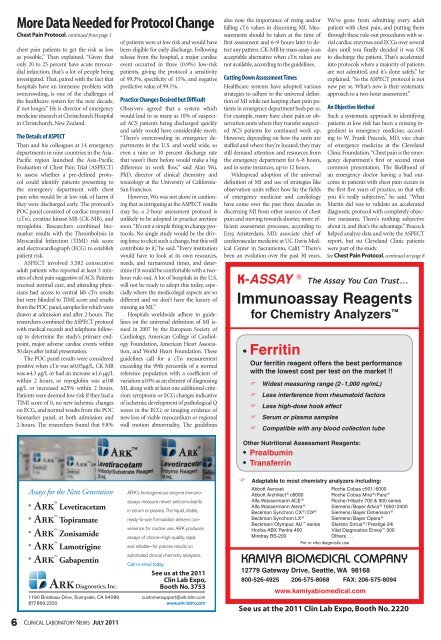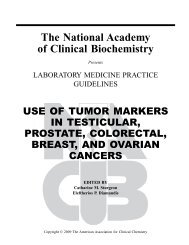Download the entire issue - American Association for Clinical ...
Download the entire issue - American Association for Clinical ...
Download the entire issue - American Association for Clinical ...
Create successful ePaper yourself
Turn your PDF publications into a flip-book with our unique Google optimized e-Paper software.
More Data Needed <strong>for</strong> Protocol Change<br />
chest Pain Protocol, continued from page 1<br />
chest pain patients to get <strong>the</strong> risk as low<br />
as possible,” Than explained. “Given that<br />
only 20 to 25 percent have acute myocardial<br />
infarction, that’s a lot of people being<br />
investigated. That, paired with <strong>the</strong> fact that<br />
hospitals have an immense problem with<br />
overcrowding, is one of <strong>the</strong> challenges of<br />
<strong>the</strong> healthcare system <strong>for</strong> <strong>the</strong> next decade,<br />
if not longer.” He is director of emergency<br />
medicine research at Christchurch Hospital<br />
in Christchurch, New Zealand.<br />
The Details of ASPECT<br />
Than and his colleagues at 14 emergency<br />
departments in nine countries in <strong>the</strong> Asia-<br />
Pacific region launched <strong>the</strong> Asia-Pacific<br />
Evaluation of Chest Pain Trial (ASPECT)<br />
to assess whe<strong>the</strong>r a pre-defined protocol<br />
could identify patients presenting to<br />
<strong>the</strong> emergency department with chest<br />
pain who would be at low risk of harm if<br />
<strong>the</strong>y were discharged early. The protocol’s<br />
POC panel consisted of cardiac troponin I<br />
(cTn), creatine kinase MB (CK-MB), and<br />
myoglobin. Researchers combined biomarker<br />
results with <strong>the</strong> Thrombolysis in<br />
Myocardial Infarction (TIMI) risk score<br />
and electrocardiograph (ECG) to establish<br />
patient risk.<br />
ASPECT involved 3,582 consecutive<br />
adult patients who reported at least 5 minutes<br />
of chest pain suggestive of ACS. Patients<br />
received normal care, and attending physicians<br />
had access to central lab cTn results<br />
but were blinded to TIMI score and results<br />
from <strong>the</strong> POC panel, samples <strong>for</strong> which were<br />
drawn at admission and after 2-hours. The<br />
researchers combined <strong>the</strong> ASPECT protocol<br />
with medical records and telephone followup<br />
to determine <strong>the</strong> study’s primary endpoint,<br />
major adverse cardiac events within<br />
30 days after initial presentation.<br />
The POC panel results were considered<br />
positive when cTn was ≥0.05µg/L, CK MB<br />
was ≥4.3 µg/L or had an increase ≥1.6 µg/L<br />
within 2 hours, or myoglobin was ≥108<br />
µg/L or increased ≥25% within 2 hours.<br />
Patients were deemed low risk if <strong>the</strong>y had a<br />
TIMI score of 0, no new ischemic changes<br />
on ECG, and normal results from <strong>the</strong> POC<br />
biomarker panel, at both admission and<br />
2-hours. The researchers found that 9.8%<br />
Assays <strong>for</strong> <strong>the</strong> Next Generation<br />
TM<br />
TM<br />
TM<br />
TM<br />
TM<br />
Levetiracetam<br />
Topiramate<br />
Zonisamide<br />
Lamotrigine<br />
Gabapentin<br />
1190 Bordeaux Drive, Sunnyvale, CA 94089<br />
877.869.2320<br />
6 CliniCal laboratory news July 2011<br />
of patients were at low risk and would have<br />
been eligible <strong>for</strong> early discharge. Following<br />
release from <strong>the</strong> hospital, a major cardiac<br />
event occurred in three (0.9%) low-risk<br />
patients, giving <strong>the</strong> protocol a sensitivity<br />
of 99.3%, specificity of 11%, and negative<br />
predictive value of 99.1%.<br />
Practice Changes Desired but Difficult<br />
Observers agreed that a system which<br />
would lead to as many as 10% of suspected<br />
ACS patients being discharged quickly<br />
and safely would have considerable merit.<br />
“There’s overcrowding in emergency departments<br />
in <strong>the</strong> U.S. and world wide, so<br />
even a nine or 10 percent discharge rate<br />
that wasn’t <strong>the</strong>re be<strong>for</strong>e would make a big<br />
difference in work flow,” said Alan Wu,<br />
PhD, director of clinical chemistry and<br />
toxicology at <strong>the</strong> University of Cali<strong>for</strong>nia-<br />
San Francisco.<br />
However, Wu was not alone in cautioning<br />
that as intriguing as <strong>the</strong> ASPECT results<br />
may be, a 2-hour assessment protocol is<br />
unlikely to be adopted in practice anytime<br />
soon. “It’s not a simple thing to change protocols.<br />
No single study would be <strong>the</strong> driving<br />
<strong>for</strong>ce to elicit such a change, but this will<br />
contribute to it,” he said. “Every institution<br />
would have to look at its own resources,<br />
needs, and turnaround times, and determine<br />
if it would be com<strong>for</strong>table with a twohour<br />
rule-out. A lot of hospitals in <strong>the</strong> U.S.<br />
will not be ready to adopt this today, especially<br />
where <strong>the</strong> medicolegal aspects are so<br />
different and we don’t have <strong>the</strong> luxury of<br />
missing an MI.”<br />
Hospitals worldwide adhere to guidelines<br />
on <strong>the</strong> universal definition of MI <strong>issue</strong>d<br />
in 2007 by <strong>the</strong> European Society of<br />
Cardiology, <strong>American</strong> College of Cardiology<br />
Foundation, <strong>American</strong> Heart <strong>Association</strong>,<br />
and World Heart Foundation. These<br />
guidelines call <strong>for</strong> a cTn measurement<br />
exceeding <strong>the</strong> 99th percentile of a normal<br />
reference population with a coefficient of<br />
variation ≤10% as an element of diagnosing<br />
MI, along with at least one additional criterion:<br />
symptoms or ECG changes indicative<br />
of ischemia; development of pathological Q<br />
waves in <strong>the</strong> ECG; or imaging evidence of<br />
new loss of viable myocardium or regional<br />
wall motion abnormality. The guidelines<br />
ARK’s homogeneous enzyme immunoassays<br />
measure newer anticonvulsants<br />
in serum or plasma. The liquid, stable,<br />
ready-to-use <strong>for</strong>mulation delivers convenience<br />
<strong>for</strong> routine use. ARK produces<br />
assays of choice—high-quality, rapid,<br />
and reliable—<strong>for</strong> precise results on<br />
automated clinical chemistry analyzers.<br />
Call or email today.<br />
see us at <strong>the</strong> 2011<br />
clin lab expo,<br />
booth no. 3753<br />
customersupport@ark-tdm.com<br />
www.ark-tdm.com<br />
also note <strong>the</strong> importance of rising and/or<br />
falling cTn values in discerning MI. Measurements<br />
should be taken at <strong>the</strong> time of<br />
first assessment and 6–9 hours later to detect<br />
any pattern. CK-MB by mass assay is an<br />
acceptable alternative when cTn values are<br />
not available, according to <strong>the</strong> guidelines.<br />
Cutting Down Assessment Times<br />
Healthcare systems have adopted various<br />
strategies to adhere to <strong>the</strong> universal definition<br />
of MI while not keeping chest pain patients<br />
in emergency department beds per se.<br />
For example, many have chest pain or observation<br />
units where <strong>the</strong>y transfer suspected<br />
ACS patients <strong>for</strong> continued work up.<br />
However, depending on how <strong>the</strong> units are<br />
staffed and where <strong>the</strong>y’re located, <strong>the</strong>y may<br />
still demand attention and resources from<br />
<strong>the</strong> emergency department <strong>for</strong> 6–8 hours,<br />
and in some instances, up to 12 hours.<br />
Widespread adoption of <strong>the</strong> universal<br />
definition of MI and use of strategies like<br />
observation units reflect how far <strong>the</strong> fields<br />
of emergency medicine and cardiology<br />
have come over <strong>the</strong> past three decades in<br />
discerning MI from o<strong>the</strong>r sources of chest<br />
pain and moving towards shorter, more efficient<br />
assessment processes, according to<br />
Ezra Amsterdam, MD, associate chief of<br />
cardiovascular medicine at UC Davis Medical<br />
Center in Sacramento, Calif. “There’s<br />
been an evolution over <strong>the</strong> past 30 years.<br />
K-ASSAY ®<br />
We’ve gone from admitting every adult<br />
patient with chest pain, and putting <strong>the</strong>m<br />
through <strong>the</strong>se rule-out procedures with serial<br />
cardiac enzymes and ECGs over several<br />
days until you finally decided it was OK<br />
to discharge <strong>the</strong> patient. That’s accelerated<br />
into protocols where a majority of patients<br />
are not admitted, and it’s done safely,” he<br />
explained. “So <strong>the</strong> ASPECT protocol is not<br />
new per se. What’s new is <strong>the</strong>ir systematic<br />
approach to a two-hour assessment.”<br />
An Objective Method<br />
Such a systematic approach to identifying<br />
patients at low risk has been a missing ingredient<br />
in emergency medicine, according<br />
to W. Frank Peacock, MD, vice chair<br />
of emergency medicine at <strong>the</strong> Cleveland<br />
Clinic Foundation. “Chest pain is <strong>the</strong> emergency<br />
department’s first or second most<br />
common presentation. The likelihood of<br />
an emergency doctor having a bad outcome<br />
in patients with chest pain occurs in<br />
<strong>the</strong> first five years of practice, so that tells<br />
you it’s really subjective,” he said. “What<br />
Martin did was to validate an accelerated<br />
diagnostic protocol with completely objective<br />
measures. There’s nothing subjective<br />
about it, and that’s <strong>the</strong> advantage.” Peacock<br />
helped analyze data and write <strong>the</strong> ASPECT<br />
report, but no Cleveland Clinic patients<br />
were part of <strong>the</strong> study.<br />
See chest Pain Protocol, continued on page 8<br />
The Assay You Can Trust...<br />
Immunoassay Reagents<br />
<strong>for</strong> Chemistry Analyzers <br />
• Ferritin<br />
Our ferritin reagent offers <strong>the</strong> best per<strong>for</strong>mance<br />
with <strong>the</strong> lowest cost per test on <strong>the</strong> market !!<br />
� Widest measuring range (2 - 1,000 ng/mL)<br />
� Less interference from rheumatoid factors<br />
� Less high-dose hook effect<br />
� Serum or plasma samples<br />
� Compatible with any blood collection tube<br />
O<strong>the</strong>r Nutritional Assessment Reagents:<br />
• Prealbumin<br />
• Transferrin<br />
� Adaptable to most chemistry analyzers including:<br />
Abbott Aeroset<br />
Abbott Architect ® c8000<br />
Alfa Wassermann ACE ®<br />
Alfa Wassermann Alera ®<br />
Beckman Synchron CX ® / DX ®<br />
Beckman Synchron LX ®<br />
Beckman / Olympus AU series<br />
Horiba ABX Pentra 400<br />
Mindray BS-200<br />
For in vitro diagnostic use.<br />
KAMIYA BIOMEDICAL COMPANY<br />
12779 Gateway Drive, Seattle, WA 98168<br />
800-526-4925 206-575-8068 FAX: 206-575-8094<br />
www.kamiyabiomedical.com<br />
� �<br />
Roche Cobas c501 / 6000<br />
Roche Cobas Mira ® / Fara ®<br />
Roche / Hitachi 700 & 900 series<br />
Siemens / Bayer Advia ® 1650 / 2400<br />
Siemens / Bayer Dimension ®<br />
Siemens / Bayer Opera ®<br />
Stanbio Sirrus ® / Prestige 24i<br />
Vital Diagnostics Envoy 500<br />
O<strong>the</strong>rs . . .<br />
see us at <strong>the</strong> 2011 clin lab expo, booth no. 2220<br />
Ferritin CLN 08-2010A.indd 1 6/29/2010 5:24:42 PM
















